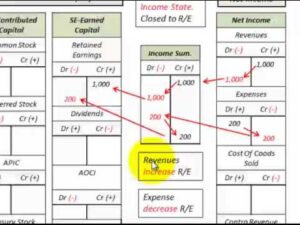
Other ledger formats list individual transaction details along with account balances. Sub-ledgers (subsidiary ledgers) within each account provide additional information to support the absorption costing vs variable costing: what’s the difference journal entries in the general ledger. Sub-ledgers are great for accounts that require more details to review the activity, such as purchases or sales. The double-entry accounting method requires every transaction to have at least one debit (incoming money) and one credit (outgoing money) entry, which must always balance out.
If he draws any money or goods from the business, this will reduce his capital, meaning that an entry should be made on the debit side of his capital account. Transactions result in an increase or decrease in the value of various individual balance sheet items. Also known as the general ledger, the ledger is a book in which all accounts relating to a business enterprise are kept. However, the business owner can easily find the total purchases amount from the purchases account. 11 Financial is a registered investment adviser located in Lufkin, Texas. 11 Financial may only transact business in those states in which it is registered, or qualifies for an exemption or exclusion from registration requirements.
After the journal entry, the debit and credit amounts will be taken to the respective ledger accounts of cash and goods. direct vs indirect costs Information is stored in a ledger account with beginning and ending balances, which are adjusted during an accounting period with debits and credits. Individual transactions are identified within a ledger account with a transaction number or other notation, so that one can research the reason why a transaction was entered into a ledger account. Transactions may be caused by normal business activity, such as billing customers or recording supplier invoices, or they may involve adjusting entries, which call for the use of journal entries. It is a separate record within the general ledger that is assigned to a specific asset, liability, equity item, revenue type, or expense type.
General Ledgers and Double-Entry Bookkeeping
Contents

This mitigates the risks that Centralized General Ledgers have from having one source control the ledger. The image below is a great illustration of how the blockchain distributed ledger works. The process of transferring information from the General Journal to the General Ledger, for the purpose of summarizing, is known as posting. Entries relating to a particular account are all collected in that account, and so its position may be known when needed.
- Information is stored in a ledger account with beginning and ending balances, which are adjusted during an accounting period with debits and credits.
- For a large organization, a general ledger can be extremely complicated.
- This type of general ledger can be used by sole traders who sell their own services or products to customers.
- This information can help management make financial and data-based decisions.
Pay your team
The equation remains in balance, as the equivalent increase and decrease affect one side—the asset side—of the accounting equation. Banks and other financial institutions are examples of business organizations that use self-balancing ledger accounts. For example, if the business owner needs to know the total amount of purchases relating to a specific accounting period, it will be difficult to find this information in the journal.
Our Services
For information pertaining to the registration status of 11 Financial, please contact the state securities regulators for those states in which 11 Financial maintains a registration filing. My Accounting Course is a world-class educational resource developed by experts to simplify accounting, finance, & investment analysis topics, so students and professionals can learn and propel their careers. Now let’s move on to talk about debits vs. credits and how they work in an accounting system. One of the entries is a debit entry and the other is a credit entry, and the amounts of both are equal.
The set of 3-financial statements is the backbone of accounting, as discussed in our Accounting Fundamentals Course. A general ledger summarizes all the transactions entered through the double-entry bookkeeping method. Under this method, each transaction affects at least two accounts; one account is debited, while another is credited. The total debit amount must always be equal to the total credit amount. Preparing a general ledger is a crucial step in the accounting process.
A general ledger account (GL account) is a primary component of a general ledger. The transactions are related to various accounting elements, including assets, liabilities, equity, revenues, expenses, gains, and losses. As per bookkeeping rules, every financial transaction affects two accounts, causing them to either gain or lose something with equal amounts. Goods purchased with cash will cause goods to be debited as an asset while cash getting credited to finance the purchase. Understanding what an accounting ledger is and its importance to your business finances can help you organize and track transactions more easily.
Create a Free Account and Ask Any Financial Question
Each ledger contains an opening balance, all debit and credit entries during the reporting period, and an ending balance. After the ledger entries, the balances of all the ledger accounts are taken to the trial balance sheet. A trial balance is a worksheet with the column of debit and credit corresponding to the rules of double-entry bookkeeping or dual aspect of accounting. Users can prepare an accounting ledger by first gathering all their financial transaction details from journals and then drawing the same details into separate columns on the ledgers. To gather journal information, users must understand debits and credits. Once they have done so, it will be much easier for them to post transactions correctly onto ledgers.
This team of experts helps joint product definition and meaning Finance Strategists maintain the highest level of accuracy and professionalism possible. With the help of ledgers, users can gain a better idea of what is going on inside their company so they may make more informed decisions and effectively manage their finances. A purchase ledger is used to keep track of all the purchases made by a business. This may include parts, supplies, equipment, and inventory for their products. Shaun Conrad is a Certified Public Accountant and CPA exam expert with a passion for teaching.
